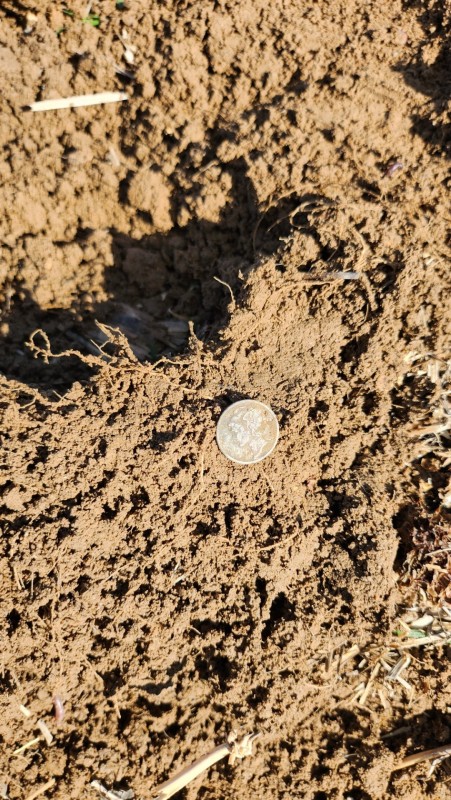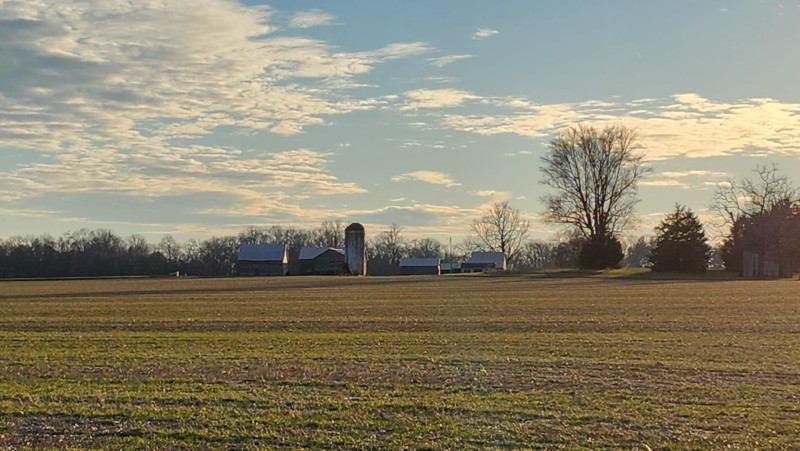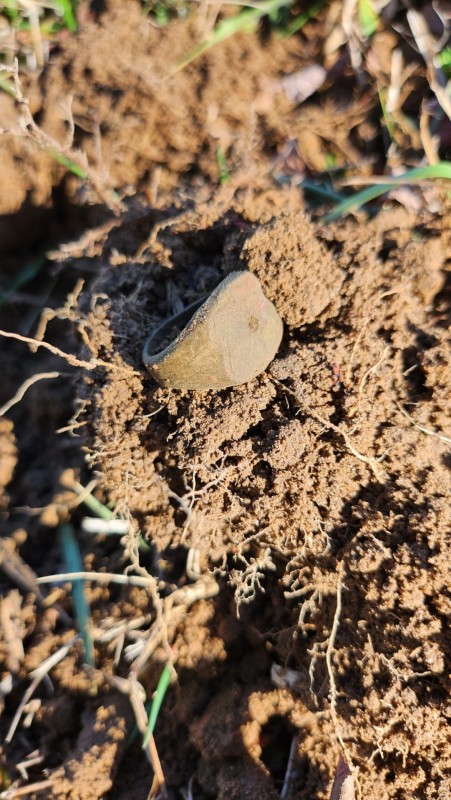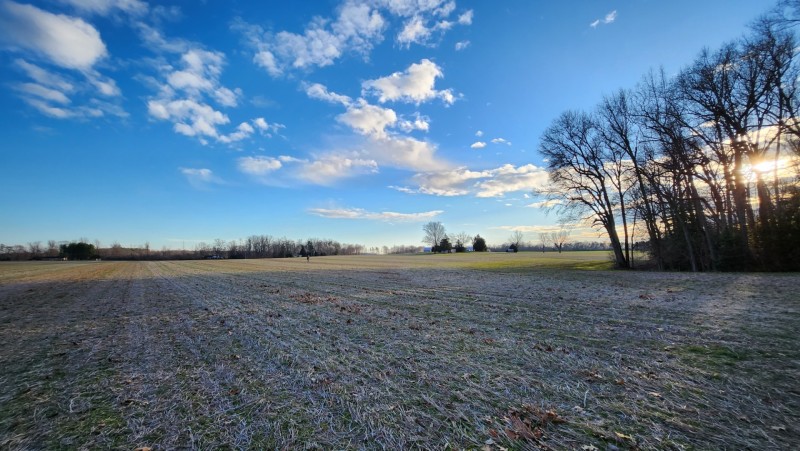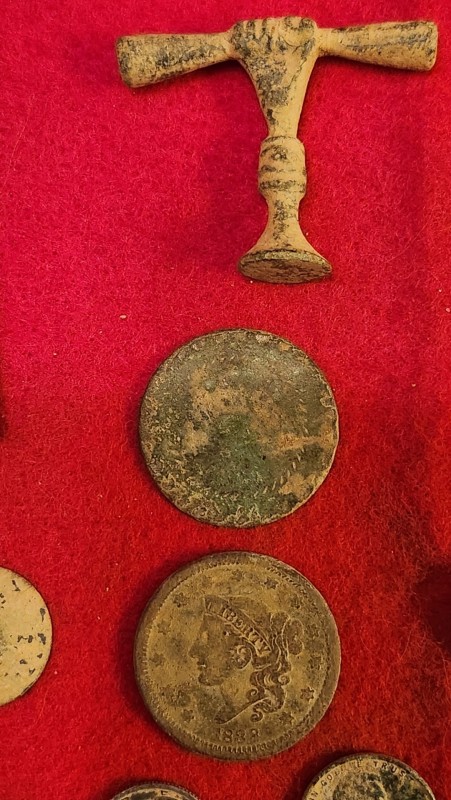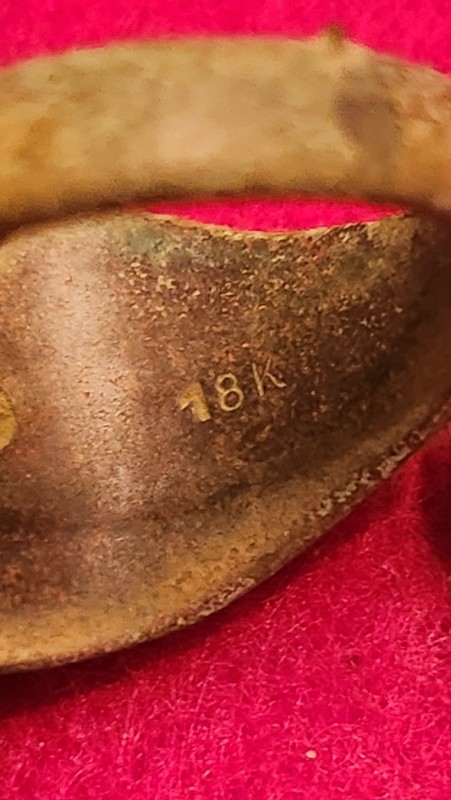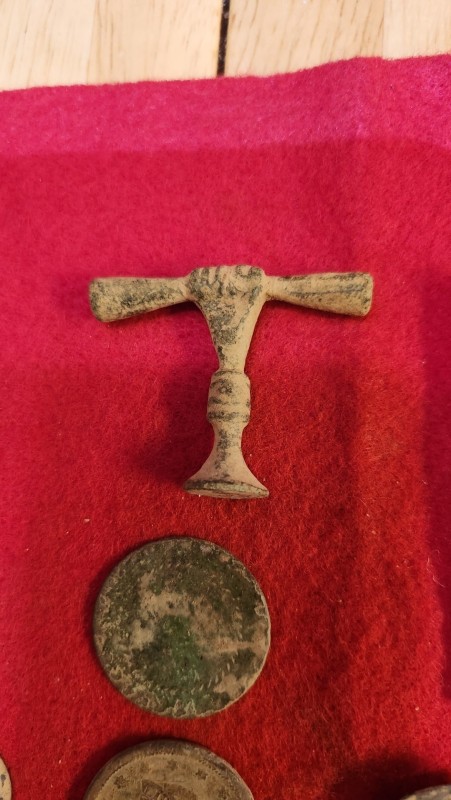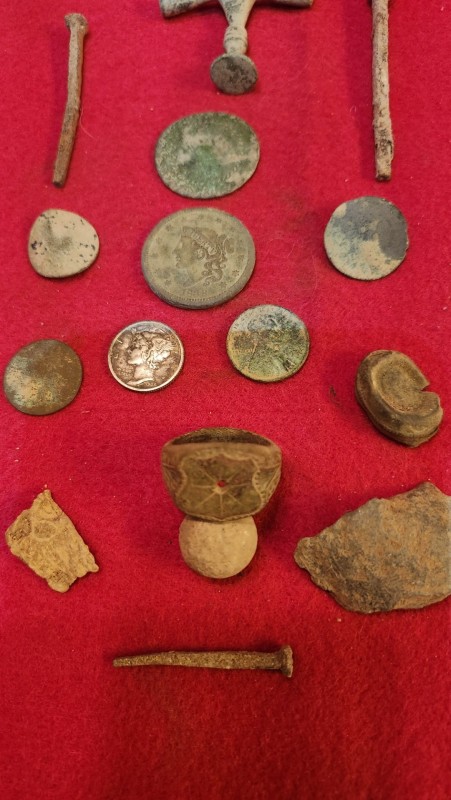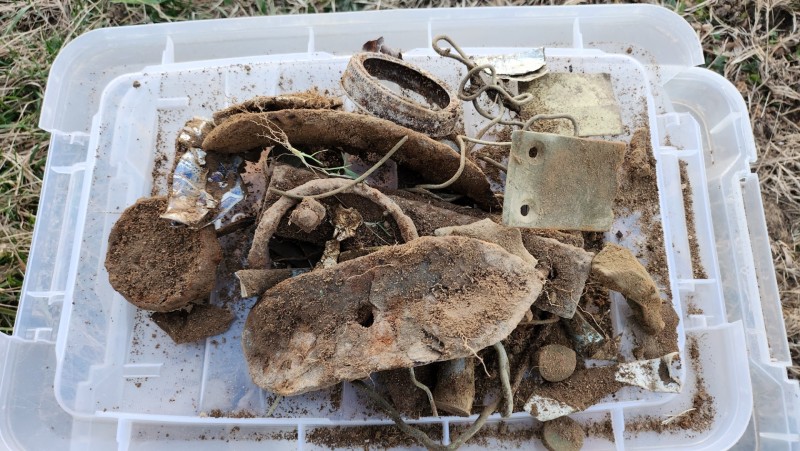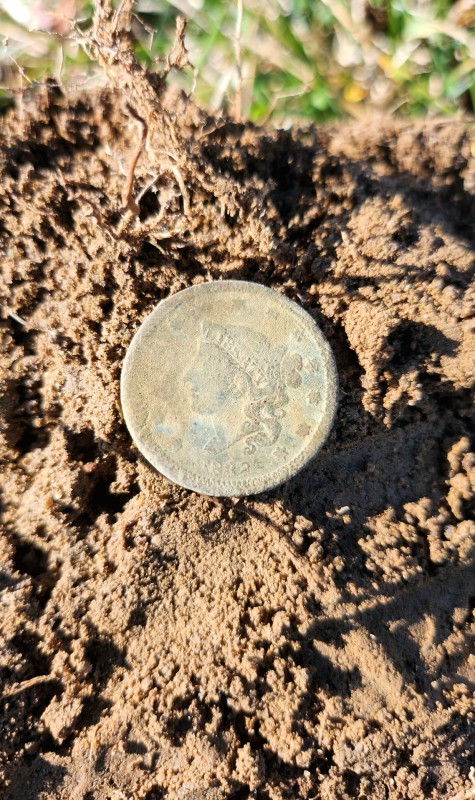-
Posts
6,119 -
Joined
-
Last visited
Content Type
Forums
Detector Prospector Home
Detector Database
Downloads
Everything posted by Chase Goldman
-
If you've been keeping up with my detecting buddy, Bob (@F350Platinum) lately, you can see that he has been busy hitting some new Virginia Northern Neck permissions this winter and finding some spectacular stuff. Bob not only finds relics and coins on his outings, he also always seems to walk away with several hundred acres of new permissions when he chats up the landowners. His integrity and reputation for respecting others's land while pursuing his relic detecting passion precedes him (word gets around in this tight knit but distributed community - the Northern Neck is a Virginia peninusla bounded by the Potomac and Rappahannock rivers - we are talking 5 counties, 5 million acres, and over a thousand miles of shoreline). The landowners not only nearly always say yes to a permission request from Bob but they also give him their knowledge of the historic background of their properties. Your're either in or out. There are no shades of gray and no tolerance for bending the rules of engagement (trespassing, leaving craters, etc.) You blow it at one permission, and you are likely toast elsewhere. Bob knows how to ask and how to behave and has become an expert researcher as well as a damn good detectorist in a relatively short period of time. It is impressive to see how far he has come in the last few years since he stepped into his back yard with his Garrett Ace 400, dug some spanish silver and flat buttons with ease (not realizing how fortunate he was to basically live in a relic detecting nirvana). I passed on my Virginia relic detecting knowledge and knowledge of detectors as I could after striking up a friendship on this site and we have been digging together ever since. He has the advantage of being retired and getting out frequently and I was able to only come down occasionally because of work and the long drive. That changed when I retired at the end of last year and have been able to get down there 4 or so times since the beginning of 2023. Regardless, the student has surpassed the teacher and Bob let's me tag along on his permissions, researches and scouts the sites, and provides the end of hunt caffeine fix so I can make it home in one piece. All I have to do is show up and dig and I can only thank Bob for his generosity, friendship, and the opportunity to dig. It's 4 hours round trip driving so I only get a few hours of daylight to make it happen, but there is something about digging therapy that makes the long drives tolerable. I was excited about our planned meetup on Monday because it was a new permission at a site with some known history that we had been eyeing for months. However, it almost did not happen on my end. I lost an important item over the weekend (discovered it Monday morning as I was getting ready to head out to Bob's) and had to wait until the offices opened up on Monday morning to retrieve it. I thought I would have to scrub the trip because I lost a couple hours dealing with the lost and found thing. Anyway, I decided to make the trip anyway, even if it meant minimal digging, and managed to get there just after lunch. Boy, I couldn't have been more wrong about the minimal digging part. Little did I know, it was going to be "one of those days" where just about everything went well such that I didn't even mind digging the junk. Bob was already there trying to scope out possible hot spots and graciously taking his time making his way to the "prize" - the farmhouse cellar hole and still standing barn and other farm out buildings. The landowner reiterated that the site had been hit hard previously but that was several years ago, I we know we had the Deus 2 advantage with its speed and reactivity and ability to unmask in iron infested environments. Swinging away as I made the quarter mile trek to where Bob was swinging in the middle of the harvested soybeans, a lucky omen. The first target I dug on the new site was a silver '35 Merc. This was a great sign. It was either all going to be gravy or that was going to be my best find of the day. Either way, I felt at that moment I made the right decision to make the trip down. Caught up with Bob, we surveyed the field which had plenty of shotgun head stamps that sounded great. He arranged for us to be able to detect the grounds around the buildings and not just the farm fields, which was an amazing coup. We get to the cellar hole area, he digs a BIG dandy button and a few minutes later I score an 1838 Largie. We high five after those finds and wondered aloud how previous diggers could have left these big targets. To be fair, they were in machine gun iron or old flower beds. But still... Turns out, it was not all rainbows and unicorns. The site was had lots of modern trash consistent with a working farm and LOTS of iron. Still managed to eek out a couple more keepers around the building and surrounding fields. On the way back, I scored a 17th or 18th century brass pipe tobacco tamper which was comprised of a hand grasping a scroll - apparently, common Colonial and early American era symbolism. Summing up, I scored the merc and the Largie in amazing shape for being in the ground for likely some 180 years or so. Four flat buttons including a large dandy with a circular design, a tombac, and couple other non-descript flats, an antique brass signet type ring with a missing stone and stamped 18K (was probably gold plated), a musket ball, some miscellaneous pieces of brass and lead, a wheatie, and finally, the pipe tamper which I thought was going to be another shotgun head stamp but dug anyway out of general principle - even though I was exhausted at that point. Dug a LOT of junk too. Mostly called it as either falsing big iron or aluminum strips but dug anyway to make sure because we came across a lot of multiple target situations. I pulled two nails out of the hole where I pulled the ring which was hiding under a big root. Saved some non-corroded old cut square nails from the cellar hole which apparently had been annealed in the kitchen hearth (which makes them corrosion resistant but also too soft to be re-used). I started out with the Deus 2 stock relic program with IAR at 5 and simply adjusted reactivity and sensitivity as necessary for the conditions (sensitivity 90+ and reactivity at 1 in the open field, lowered sensitivity into the 80's and increased reactivity to 2.5 in the machine gun iron). Worked great and decided to stick with it for the entire hunt. Also switched between the 11" coil for the field and the 9" for the grounds where target density was insane. Read more about this hunt from Bob here.
-
It wouldn't spread them "all over the VDI range", it would spread them out a little better in the 90's (provide a better ability to resolve small differences in high conductors) like with the Deus 1 operating at less than 18khz, (i.e., more consistent with other detectors with 0-99 VDI scales.)
-

Quest V80, V60 Coming Soon!!
Chase Goldman replied to George Kinsey's topic in Quest Metal Detectors
George, I'm just going by what Quest actually wrote in their marketing materials. Nothing there about 80+ simultaneous frequencies. 80khz is the top end frequency in simultaneous multi-frequency but, like Nox, Manticore, Legend and D2 we are probably talking 2 or at most 3 frequencies being transmitted simultaneously. It really doesn't matter though. As Steve said. what matters is how they are processing the resulting target signal and how it ultimately stacks up against Legend, Nox, Nanticore and Deus 2. On paper it looks really great and the mega bundle looks like a great value. -

Quest V80, V60 Coming Soon!!
Chase Goldman replied to George Kinsey's topic in Quest Metal Detectors
My only gripe would be if they limited VCO/Pitch audio to gold mode only as they only mention the standard 2, 3, 5, 99 tones. Minelab wised up and took a cue from Nokta and put dP (pitch) as an audio option for all Nox 900 modes. (Pretty minor gripe). -

Quest V80, V60 Coming Soon!!
Chase Goldman replied to George Kinsey's topic in Quest Metal Detectors
George - this source says HyperQ (that's original) can transmit from 7khz up to above 80khz, but not 80+ multiple simultaneous frequencies. It does say it will transmit 5,10,15, 20, 40, and 60 khz simultaneously (where's the 80 khz?). It also seems they are contradicting themselves a la Minelab's Nox marketing information error on MultiIQ by conflating the multiple individual selectable single frequencies with the HyperQ SMF frequency range, as metal detector designers know that trying to blast 6 frequency waveforms into the ground simultaneously is not necessarily a good SMF implementation. All the other usual suspects and features are here - that's a good thing - as well as reasonable price points. Sounds like the Quest "Hype" machine is going full blast. All that all being said, I have liked the quality of my Quest accessories and am interested to see what the V60/80 actually bring to the table and like that another manufacturer has entered the simultaneous multi-frequency detector fray (good for competition). -
There's a whole hobby centered around restoring/upgrading watches using vintage cases, so it is definitely something that can be done.
-
You are correct, though as mentioned previously gold conductivity target ID varies greatly with the mass, shape, and purity of the gold alloy so there is no ideal frequency. Generally, lower frequencies get maximum ground penetration and depth vs. higher frequencies but they are less sensitive to micro targets and lower conductors like alloyed gold. A large gold ring of higher gold alloy content that will ring up with a high TID might be hit deeper with a lower frequency setting or Park mode in dry sand, but it is not generally an ideal setting on a wet salt beach and will be less reactive to smaller gold. Any single frequency or even "Park" modes on a simultaneous multifrequency (SMF) detector like an Equinox, Manticore, Deus 2, or Legend will run less stable in wet salt sand or saltwater than an SMF dedicated "Beach" mode that is designed to balance salt out. So I don't know what the 800 guy on the beach was saying to the OP about 4 khz hitting gold better at the beach. Perhaps he was trying to "throw off" a percieved newbie/competitor (it unfortunately does happen with unscrupulous detectorists when there's competition for scarce targets), was being imprecise about how he was actually using 4 khz with the 800 there, or he genuinely was misinformed. Regardless, it appears to be a stunningly bad "general" tip to pass along (without specific context), especially since he was running a SMF detector with more optimal beach modes. On the beach, higher frequencies do interact with salt more (for the very same reason they "excite" gold targets more) giving more ground noise chatter such that it's hard to run the machine in a stable manner. So for single frequency machines that have multiple adjustable frequency settings you can get more wet salt stability by running the machine at lower frequencies but you do sacrifice depth and sensitivity on gold and lower conductive precious metals and micro-jewelry. And if the machine is not designed to balance to salt at those settings, it may still run unstable. For SMF machines, you generally can't get the machine to run stable in wet salt sand in the SIngle Frequency or non-Beach SMF modes. OP apparently found this to be the case. That's why on a salt beach, there really is no reason not to run the designated multifrequency "beach" mode if you are running in wet salt sand or salt water to get maximum stability and performance across low and high conductive targets. Beach modes are not optimal for small gold and micro targets on dry sand, but will work. Therefore, on dry sand, where salt stability is a non-issue, even at salt water beaches, run whatever frequency or mode is most conducive to the primary target of interest (low frequencies or SMF "Park" modes for deep high conductors like coins or higher frequencies or SMF "gold" modes for gold and micro jewelry). HTH
-
Yeah, I think Citizens or Seiko. Though Seiko dive watches usually have a stem and crown offset from the standard 90 degrees orientation (more like 120 degrees). Sometimes the crown has some marks on it. The rotating bezel is somewhat unusual with the Zero's between the 10 minute increments and its also unusual to see "60" vice "0". The knurled bezel looks "Seiko-ish".
-
Was the stem still intact?
-
Hopefully, Gary chimes in too. But I can tell you what I know based on my experience with both D1 and D2 so far, but need to do some additional testing verify some things. Also, see my previous post responding to CPT_GhostLight. First of all with respect to the settings above, there should be no appreciable performance difference with those two different disc and notch settings. It's just a matter of whether you want hear ferrous (or other) targets between 6 and 10. If you don't, pick 6. If you do, pick 10. I don't think that soil mineralization would have much impact on this unless you were searching for low conductive non-ferrous micro or ferrous masked targets. During Deus 1 boot camp sessions, Andy Sabisch would demonstrate using air tests that there is no depth performance hit even if you run Disc up to 15 which is really the upper ferrous limit but practically, not very much ferrous rings up between 10 and 15 in my experience. I have seen people test the D1 and ORX with disc as high as 60 with seemingly little to no depth loss in mild, sandy soils. I suspect, but haven't verified, that you would take a depth hit if you ran disc that high in moderately to highly mineralized soils. Also, you have the issue I mentioned previously regarding all targets below the high disc setting sounding off as ferrous.
-
If you don't run disc too low (i.e., set it to between 7 and 10) then you will still hear the iron up to 7 or 10 or falsing big iron (97-99) even if you notch to 40 or 50 because you have iron volume but all that lite non-ferrous junk is silenced. But that's also the reason why you don't disc to 40 or 50 because everything up to 40 or 50 will sound off with a ferrous tone with iron audio on. Also, you might take a target depth performance hit running disc that high but that's subject to conjecture (see my post below in response to Carolina).
-

Why The Tarsacci Works For Me
Chase Goldman replied to The_Stalker's topic in Tarsacci Metal Detectors
Yeah, but can it survive the USPS? (Inside joke for those of you not familiar with Carolina's shipping experience a few years back...) 😉 -
Yes. The high conductors are really scrunched up there in the 90's. I do think XP is going to address this. I know it is possible to spread these TIDs out because they did so on the original Deus if you used the lower frequencies. On Deus 1, if you normalized target ID then all target IDs were normalized to what they would be if running 18khz regardless of the actual operating frequency (Note: TID normalization was only applicable to the original LF and X35 coils, the HF coils did not feature TID normalization as an option, so TIDs varied with frequency and the IDs were really compressed significantly when running the HF coil at 25khz or greater). So hopefully XP will give us the option to select the normalization reference to spread the target IDs as the user sees fit. Perhaps two normalization settings - Legacy and "Wide". But frankly, it's not really a show stopper for me, as even on the D2, zincolns and pennies rarely masquerade as dimes, quarters, or halves and frankly whether it's ringing up as a dime, quarter, or half makes no practical difference in my dig decision (i.e., I've never personally encountered a situation where I'm cherry picking halves over quarters), so I'll find out what it really is once I get it out of the ground, anyway.
-

Do I Trust My Manticore In The Water?
Chase Goldman replied to phrunt's topic in Minelab Manticore Forum
Those are great phones. 👍 -
Not with the stock coil. Seemed to run more stable TID at a local ball field, but at relic sites I've been to the last couple of weeks could not get it to run stable above 16 sensitivity due to EMI so went with the D2 which was stable close to Max sensitivity. So there's that.
-
It's in the new Deus 1 V6 Manual you can download here. The specific pairing instructions are on p. 24. See excerpt below:
-
It's a non-issue as long as there is any continuous conductor present because neglible current is flowing and you just need continuity to the unshielded end. I doubt it will corrode enough to break or that you can actually visually monitor the progression to know when it will fail. The outer silver oxide corrosion layer may actually inhibit and slow down corrosion of the copper clad. Anyway, you'll quickly ascertain when it does fail (loss of signal submerged) so it makes sense to have a ready backup length of coax or spare OEM antenna assembly in standby.
-
Gotcha. I just figured the the further you run it up the metal shaft, the more attenuation occurs, with the mid point probably being the worst. The closer you are to either end of the upper less attenuation. Couldn't say where in the upper Parkgt terminated the waveguide so I just assumed it was being attenuated by the upper shaft metal. I'll have to run some tests myself because the "cut to suit" coax solution seems best. It also looks like that's where XP is headed with their new antenna pack.
-
Some context regarding the site would be helpful including geographic region where it was found.
-
See my explanation in the previous post above.
-
Yeah. That shouldn't be an issue. It's a wave guide so it's only radiating at the unshielded end of the coax (not along its length), so as long as there is no metal between the end of the waveguide and the receiver (remote or WS6) then there should be no issue even if it passes through metal. The problem people were having was if they terminated the waveguide run inside the metal shaft where the metal shaft was blocking the rf radiating from the end of the waveguide to the receiver If you do this, the radiating end of the coax needs to get close to the receiver or you can just terminate it in the non-metal CF lower shaft and it will work unless the waveguide tip gets submerged. Remember, the signal is normally transmitted from the coil all the way to the remote without the need for a waveguide, so as long as the coil transmitter or waveguide tip is neither submerged in water nor enclosed in metal (e.g., the waveguide run is not terminated within the upper metal shaft), then the wireless signal to the remote should be unimpeded.
-

Do I Trust My Manticore In The Water?
Chase Goldman replied to phrunt's topic in Minelab Manticore Forum
Thanks for pointing this out. Based on some of Tom's over the top proclamations (like Nox coils burning up if they were connected to the higher power Manticore) its not clear to me whether he has the expertise to actually be part of the ML M-core design team or just an outside expert user offering feedback as a consultant/tester to ML (one of many) that also happens to have a lot of loyal website users. To me the "horse" would be Mark Lawrie - ML's Chief Engineer. If Tom is speaking for ML as a designer with his "We" statement, it would be an interesting formal admission from ML that there were indeed some potential design shortcomings with the original Nox watertight design. Regardless, this is a great reminder that ML did get an IP68 rating for Manticore (and Equinox 700/900 for that matter). ML appears to have definitely improved Manticore and Nox 700/900 design in terms of waterproof integrity over the first gen EQX and the fact that they are able to actually specify an IEC Ingress Protection (IP) rating this time around (and not with the first gen Equinox which has NO advertised IP rating) which requires submission of documented test results to advertise the 5M submersion spec as IP68, is a good sign. Plus they have never been accused of not standing behind their warranty (and in some cases even beyond the warranty) on the original Nox with all the reported water intrusion issues. -
What type of soil are you digging in? I've never seen dug 160 year old brass come out of the ground looking like that even after cleaning it up. That's amazing.
-
Do you have it terminated at the remote or just have it running part way up the upper shaft, Dave? The question was whether you could run it part way up the upper shaft but leave it in the shaft. Doesn't work with the metallic upper, should work with a total CF shaft system.
-
One additional thought on this excellent post by Jeff - just as there is a point of diminishing returns (i.e., additional noise and lower stability (that manifests as chatter)) when increasing sensitivity, there is also a point of diminishing returns when lowering recovery speed. Besides the fact that users have reported little difference in their ability to hear fringe targets at the lowest recovery speeds vs. the typical defaults (4, 5, and 6), lowering recovery speed beyond what is necessary will also cause you to hear more ground noise which will be picked up as chatter in hot dirt as well as wet salt sand. So really, the name of the game is optimizing the settings to give you the desired separation and depth capability as well as minimizing chatter and ground noise (maximizing signal to noise ratio). Many people have noted that ML has done a pretty good job at setting the defaults for the user adjustable parameters such as sensitivity, recovery speed, and iron bias at pretty good starting points and only slight adjustments for site conditions usually all that is needed to make them optimal if they aren't already there.


